
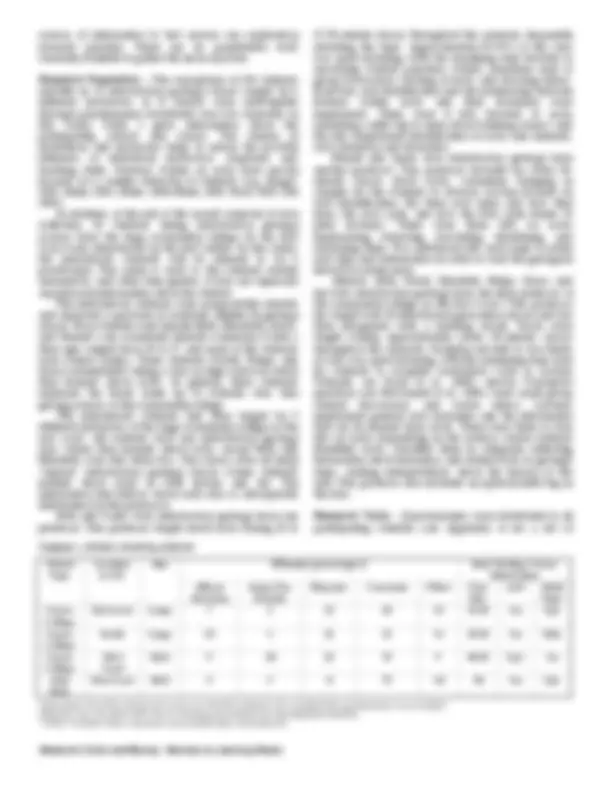
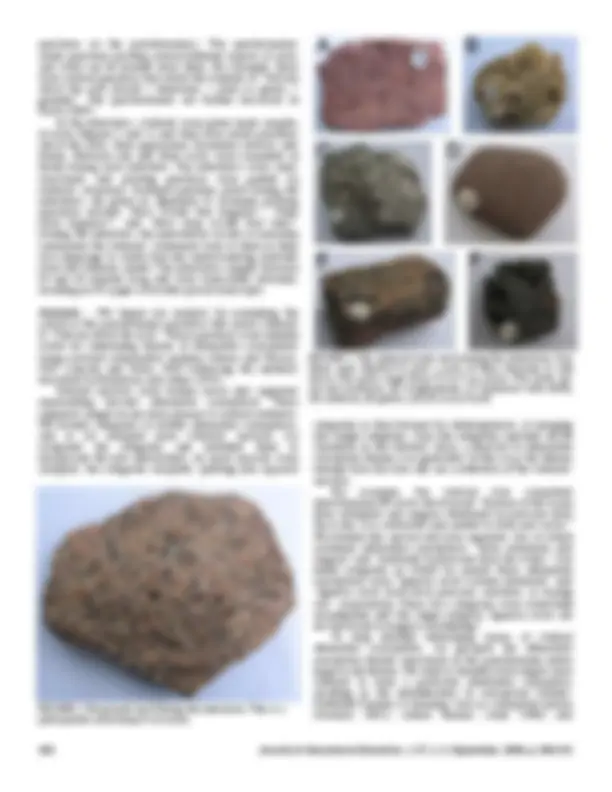
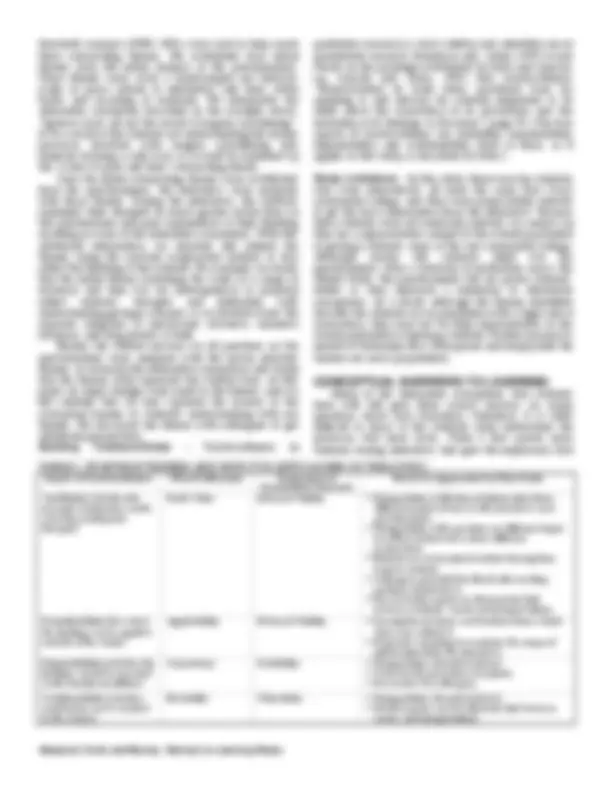
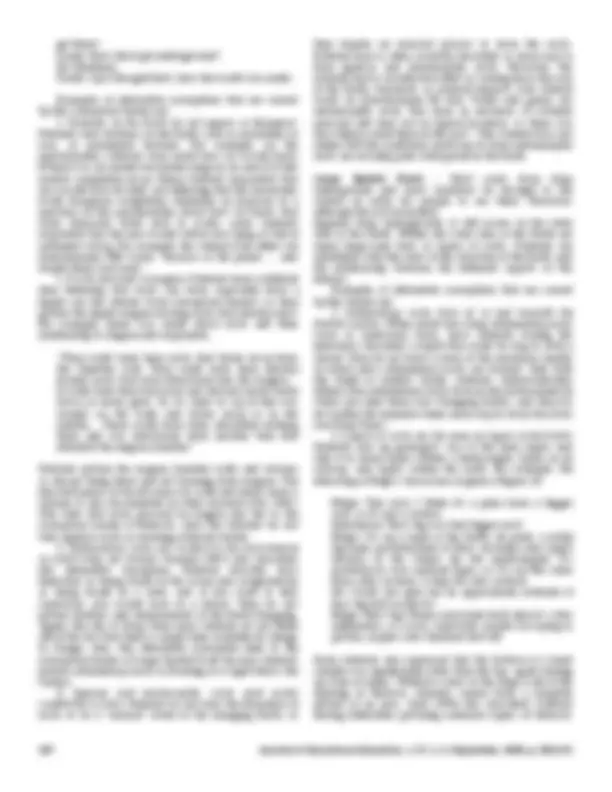
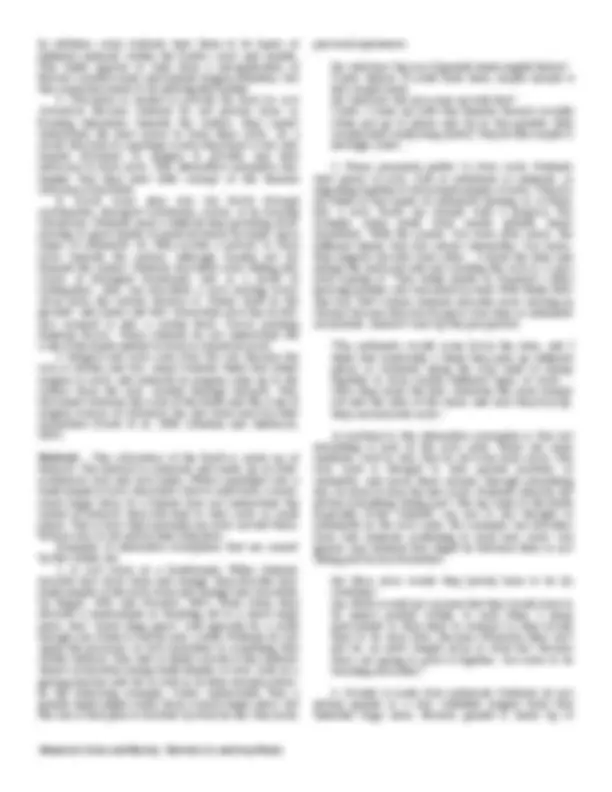
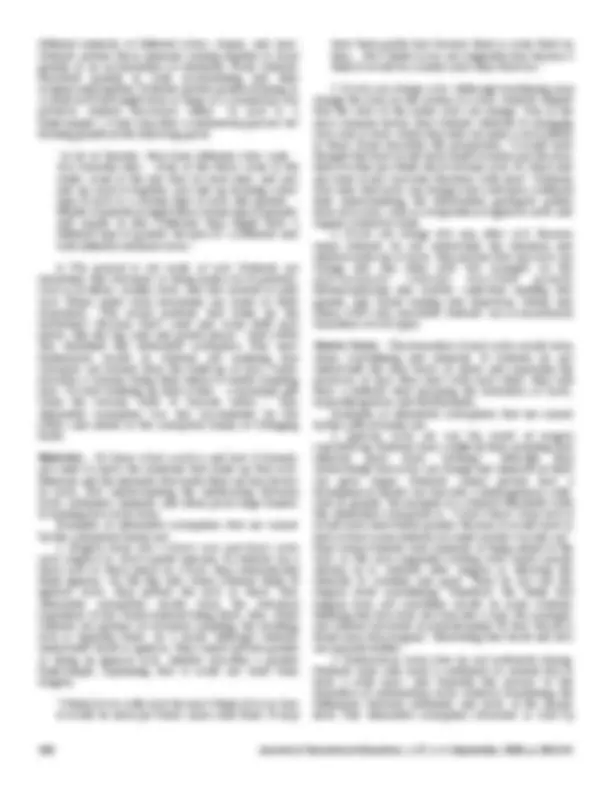
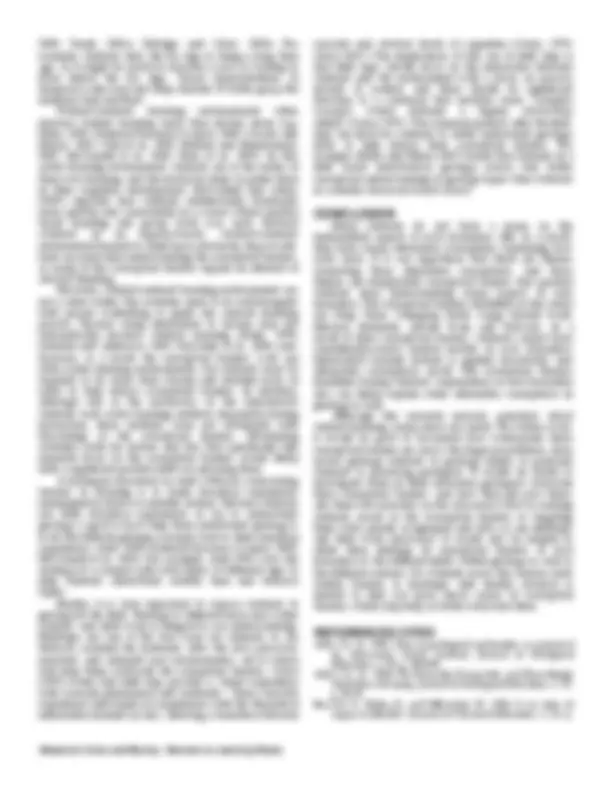
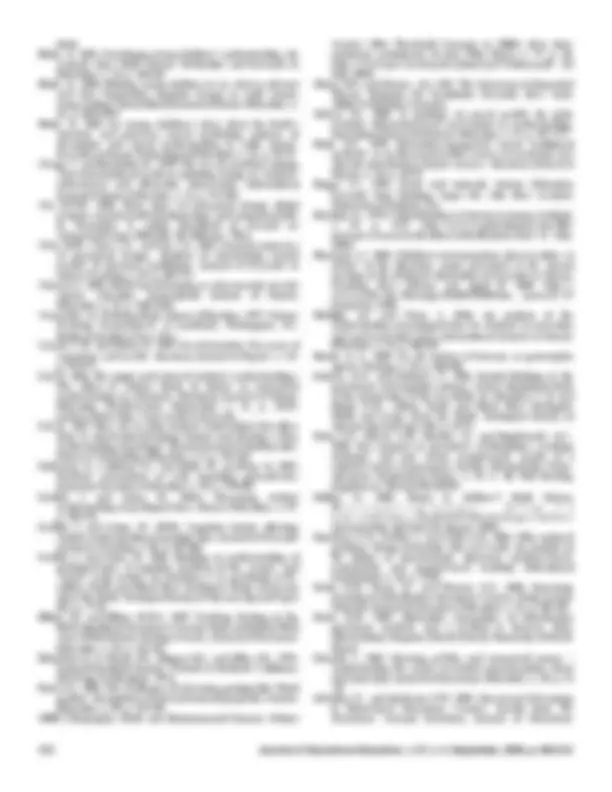
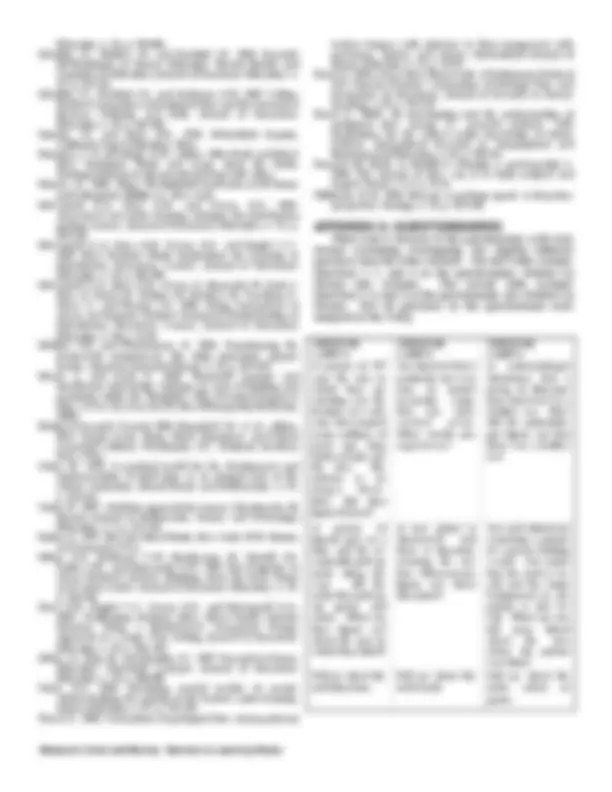


Study with the several resources on Docsity

Earn points by helping other students or get them with a premium plan


Prepare for your exams
Study with the several resources on Docsity

Earn points to download
Earn points by helping other students or get them with a premium plan
Community
Ask the community for help and clear up your study doubts
Discover the best universities in your country according to Docsity users
Free resources
Download our free guides on studying techniques, anxiety management strategies, and thesis advice from Docsity tutors
Research on college students' alternative conceptions of rock formation and identifies seven conceptual barriers that prevent students from understanding the scientific explanations of how rocks form. These barriers include Deep Time, Changing Earth, Large Spatial Scale, Bedrock, Materials, Atomic Scale, and Pressure.
What you will learn
Typology: Summaries
1 / 16

This page cannot be seen from the preview
Don't miss anything!










Research: Kortz and Murray - Barriers to Learning Rocks
Rocks and how they form are among the fundamental topics in geology because we need to understand them in order to understand Earth’s history and processes. The three rock types and the rock cycle are essential topics students should learn in college-level introductory geoscience classes (Kelso et al., 2000). Although rocks are a key element in most introductory classes in lectures, labs, and/or field trips, there is scant research on college students’ conceptions (or alternative conceptions) of rock formation (Kusnick, 2002; Kortz, 2009). To being able to effectively teach students scientific material, it is important to know if they are entering the classroom with alternative conceptions and what those alternative conceptions are. Students are not blank slates, and they use their prior knowledge to construct ideas about the Earth (e.g. Chang and Barufaldi, 1999; Kusnick, 2002; Taber, 2003). Although this prior knowledge may be non-scientific, students may still use it as a base for new knowledge taught in the classroom. As a result, they construct an inappropriate mental model, or representation of the phenomena. Therefore, students cannot learn the scientific perspective if they have their alternative conceptions still in place (e.g. Committee on Undergraduate Science Education, 1997; Clement, 2000; Gobert, 2000; National Resource Council, 2000; Taber, 2003; Chi, 2008). By knowing what those potentially non- scientific ideas are, instructors, researchers, and curriculum developers are better able to achieve an understanding of students’ learning difficulties and help them appropriately. Previous research on students’ conceptions of rocks has focused mostly on children and how they describe and classify rocks (e.g. Happs, 1982; Blake, 2001; Blake, 2004; Blake, 2005; Ford, 2005; Dal 2006). However, Kusnick (2002) investigated pre-service elementary school teachers on their conceptions of rock formation based on writing assignments the students completed during the semester. She described many common alternative conceptions of
those students and noted deeply-held beliefs of students that lead to those alternative conceptions. Similarly, Kortz (2009) found that college students in introductory geology classes do not view rocks as part of processes but instead as individual objects that often do not change. Notably, because many students view rocks as static objects, they may not intuitively understand that rocks form and change over time. Moreover, students often mix up the three rock types and do not discriminate between the distinct formation processes that distinguish them (Kortz, 2009). Several investigators have examined in greater depth the underlying factors behind many of the alternative conceptions students have science in general, and about rocks in particular. We present a synopsis of their work as it pertains to the difficulties students have in understanding the rock cycle, that is organized around the terminology those investigators have introduced into the geoscience literature.
Critical Barriers – Hawkins (1978) identified “critical barriers” that prevent students from fully understanding scientific phenomena, and Ault (1984) applied them to rock formation. They define a critical barrier as “exceedingly unobvious” ideas that are difficult to overcome, since patient explanation rarely immediately cures it (Hawkins, 1978; Ault, 1984). Although grasping critical barriers is necessary to understanding in a discipline, they are often mastered relatively late in the learning of a science, despite their “elementary” nature. They often result from the conflict between common sense, intuitive, everyday notions about phenomena and the structure of scientific thoughts. Critical barriers are typically fundamental or basic concepts in a discipline, with the intimation that they should be easy to grasp. To the contrary, they are usually complex and subtle ideas, which are the end product of years of scientific research and controversy. They also presume significant prior knowledge about the topic, a point that becomes immediately evident when you attempt to “unwrap” a critical barrier. This occurs when developing STEM curricula that address grade span expectations (i.e.,
1
2
(^1) Physics Department, Community College of Rhode Island, 1762 Louisquisset Pike, Lincoln, RI 02865; kkortz@ccri.edu (^2) CELS – Department of Geosciences, University of Rhode Island, Woodward Hall, Kingston, RI 02881; dpmurray@uri.edu
Students do not have a good understanding of how rocks form. Instead, they have many non-scientific alternative conceptions to explain different aspects of rock formation. Using 10 interviews and nearly 200 questionnaires filled out by students at four different colleges, we identified many alternative conceptions students have about rock formation. We then used themes within those alternative conceptions to identify the underlying conceptual barriers that cause them. Conceptual barriers are deeply-held conceptions that prevent students from understanding scientific explanations. One conceptual barrier can cause many alternative conceptions, and alternative conceptions can be the result of more than one conceptual barrier. The seven conceptual barriers identified in the study that prevent students from understanding rock formation are Deep Time, Changing Earth, Large Spatial Scale, Bedrock, Materials, Atomic Scale, and Pressure. Because of these conceptual barriers, students cannot form scientifically correct mental models of how rocks form, resulting in alternative conceptions, so the conceptual barriers need to be overcome before students truly learn the scientific explanations of how rocks form. The results of this study can be applied to other areas of geology in addition to rock formation.
301 Journal of Geoscience Education, v. 57, n. 4, September, 2009, p. 300-
standards) for K-12, as they often unwittingly list critical barriers as standards. Examples of specific critical barriers we have encountered in geoscience courses include the rock cycle, strike and dip, cladograms, and earthquake prediction. Of relevance to this paper is the classification of Ault (1982, 1984). He identified four broadly defined barriers to understanding the formation of rocks:
Conceptual Prisms – Although the concept of critical barriers gives us a convenient framework for describing and categorizing ideas that students find difficult to grasp, it provides little insight into the reasons why these barriers occur. The work of Kusnick (2002) is germane, as she demonstrated that students have deeply held beliefs about the world, termed “conceptual prisms,” that distort their understanding of how rocks form. Conceptual prisms result from the interaction of the student’s world view and personal experience with what they were taught about rocks. They are deeply held but largely unexamined beliefs that refract geologic instruction, resulting in a spectrum of ideas about geology. The four conceptual prisms suggested by Kusnick are:
Clearly Ault’s critical barriers to understanding rocks share much in common with Kusnick’s conceptual prisms. However, the latter classification attempts to identify a deeper and more general set of barriers to learning that apply not only to understanding the rock cycle, but also to many other scientific ideas. This issue is the subject of an extensive literature that addresses the reasons why humans find seemingly “simple” scientific and mathematical concepts so difficult to grasp. It draws heavily from cognitive science and evolutionary psychology, and implies that there are universal constraints on how we process information, and that these constraints are “hard-wired”. A review of this work is beyond the scope of this paper, and the reader is referred to Pinker (1997) and Marcus (2008) for entrées to the literature.
Threshold Concepts – Most recently, “threshold concepts” have been invoked to explain difficulties that students have in learning many topics over a wide range of disciplines (Meyer and Land, 2003; Stokes et al., 2007). Threshold concepts are a “mental blockage” that when cleared results in understanding or ‘insight’ opening up a
whole new way of thinking or practicing in a discipline. They represent a transformed way of understanding, something without which the learner finds difficult to progress within the curriculum. Although little research has been performed to identify threshold concepts in geology, an extensive list was created of possible threshold concepts at a workshop on threshold concepts in geography, earth, and environmental sciences (Geography, Earth and Environmental Sciences Subject Centre (GEES), 2006). The workshop participants (GEES,
The “mental blockage” of Meyer and Land is the same as Ault’s critical barrier. However, unlike Ault, Meyer and Land are focused on the transformative process by which the barrier is removed.
Conceptual Barriers – In this study, we identify common alternative conceptions of college students’ understanding of rocks and their formation. Our goal is to use patterns in these alternative conceptions to find their underlying conceptual causes which pose barriers to students’ comprehension. As Libarkin and others wrote (2003), “Understanding the common thought processes applied to different content matter is a powerful method for understanding how students view the world around them.” The findings of previous studies regarding barriers to learning are used as an initial platform to aid in our investigation of the underlying conceptual causes. Although they are not completely analogous, critical barriers, conceptual prisms, and threshold concepts all are concerned with the barriers to learning, and the ways in which they may eliminated. We will use the term conceptual barrier in this paper to describe this idea. As used in this paper, a conceptual barrier is an underlying, deeply held conception that prevents students from understanding the scientific explanation. Here, the term also refers to the underlying causes of the barrier, and the ways in which they can be eliminated.
Methodological Approach – We used a qualitative approach to identify alternative conceptions of students and analyze them for underlying conceptual barriers. Specifically, we relied on in-depth interviews of students’ views of rocks and their formation and questionnaires about rocks and interpretations made from rocks. We chose a qualitative approach in order to gather rich
303 Journal of Geoscience Education, v. 57, n. 4, September, 2009, p. 300-
questions on the questionnaires). The questionnaires asked questions probing several different aspects of rocks and what can be learned from them. For example, there were several questions that asked the students to “Tell me about the rock [basalt / limestone / schist or gneiss / granite].” The questionnaires are further discussed in Kortz (2009). In the interviews, students were given hand samples of rocks (Figures 1 and 2), and they were asked questions about the rocks, their appearance, formation, history, and future. Between one and three rocks were examined in detail during each interview. The interviews were semi- structured, and probing questions were guided by students’ responses. Example questions asked during the interviews are given in Appendix B. Example probing questions include “How would that happen?”, “Then what happens?”, and “How long would that take?” During the interview, the interviewer would occasionally summarize the students’ statements back to them in their own language to verify that her understanding matched what the students meant. The interviews ranged between 20 and 60 minutes long and were transcribed verbatim, resulting in 192 pages of double-spaced transcripts.
Analysis – We began our analysis by examining the subset of the questionnaire questions that asked students to “Tell me about the rock.” These questions were initially coded for underlying themes of alternative conceptions using constant comparative analysis (Glaser and Strauss, 1967; Lincoln and Guba, 1985) following the methods described by Erlandson and others (1993). Student answers were broken down into segments representing discreet alternative conceptions. These segments ranged in size from phrases to several sentences. We formed categories of related alternative conceptions, and as we analyzed more students’ answers, we compared the categories and modified them to incorporate the new information. As more answers were analyzed, the categories morphed, splitting into separate
categories as they became too heterogeneous, or merging into single categories. Once the categories captured all the variations in the students’ ideas, a final list of alternative conception themes was generated. In this way, the themes emerge from the data and are a reflection of the students’ answers. For example, the student who completed Questionnaire 8F wrote about basalt: “Bottom of the ocean from sediments and magma. Hardened by pressure from the water. It is subducted and melted to form new rocks.” We divided this answer into four segments, two of which contained alternative conceptions: “from sediments and magma” and “hardened by pressure from the water.” Our initial categories in which we placed these alternative conceptions were “Igneous rocks contain sediments” and “Igneous rocks form from pressure, reactions, or drying out,” respectively. These two categories were eventually reconfigured into the single category “Igneous rocks are not the result of magma crystallizing.” To help identify underlying causes of student alternative conceptions, we grouped the alternative conception themes uncovered in the questionnaire under larger-scale themes. We tried to identify what might cause students to have a particular alternative conception, resulting in the identification of conceptual barriers. Published barriers to learning, such as conceptual prisms (Kusnick, 2002), critical barriers (Ault, 1984), and
FIGURE 1. The granite used during the interviews. This is a pink granite, measuring 13 cm across.
FIGURE 2. The optional rocks used during the interviews. Stu- dents were directed to pick a rock of their choosing to talk about. The rocks range from 3.5 to 5 cm across. The rocks are: (A) red sandstone, (B) conglomerate, (C) limestone with shells, (D) siltstone, (E) gneiss, and (F) scoria basalt.
Research: Kortz and Murray - Barriers to Learning Rocks
threshold concepts (GEES, 2006), were used to help create these overarching themes. We established four initial themes from the initial analysis of the questionnaires. These themes were: rocks = handsamples not bedrock; scales of space (atomic to kilometers) and time; stable Earth; and recycling of materials. We interpreted the alternative conception described in the example above, “Igneous rocks are not the result of magma crystallizing,” to be a result of the students not understanding the atomic processes involved with magma crystallizing into minerals forming a solid rock, so it could be explained by the “scales of space and time” overarching theme. Once the initial overarching themes were established from the questionnaires, the interviews were analyzed with those themes. During the interviews, the students explained their thoughts in much greater detail than on the questionnaire and gave explanations of their thinking resulting in some of the alternative conceptions. With this additional information, we adjusted and refined the themes using the constant comparative method to best reflect the thinking of the students. For example, we found that the initial theme combining the scales of a range of distances and time was too heterogeneous to properly reflect students’ thoughts and difficulties with understanding geologic concepts, so we divided it into the separate categories of microscopic distances, immense distances, and long periods of time. Finally, the student answers on all questions on the questionnaires were analyzed with the newly adjusted themes, to reclassify the alternative conceptions and verify that the themes truly represent the student data. At this point, no major changes were made to the themes, and we felt satisfied that we had captured the essence of the conceptual barriers to students’ understanding with our themes. We discussed the themes with colleagues to get additional perspectives. Building Trustworthiness – Trustworthiness in
qualitative research is what validity and reliability are in quantitative research. Erlandson and others (1993) wrote (based on the paradigm established by Guba and Lincoln, e.g. Lincoln and Guba, 1985) that trustworthiness “demonstrate[s] its truth value, provide[s] basis for applying it, and allow[s] for external judgments to be made about the consistency of its procedures and the neutrality of its findings or decisions” (page 29). The four aspects of trustworthiness are credibility, transferability, dependability, and confirmability. Each of these, as it applies to this study, is described in Table 2.
Study Limitations – In this study, there were ten students who were interviewed, all from the same East Coast community college, and they were purposefully selected to get the most information from the interviews. Because these students were not randomly selected, we cannot say they are a representative sample of the overall population of geology students, even at the one community college. Although nearly 200 students filled out the questionnaires, from a diversity of institutions across the United States, the questionnaires did not probe students’ beliefs so they represent a minimum of alternative conceptions. As a result, although the themes identified describe the students in our population with a high rate of consistency, they may not be fully representative of the overall population of geology students. Further research is needed to determine how widespread and deeply held the barriers are across populations.
Many of the alternative conceptions that students have will still give them correct answers on many questions about rock formation. Therefore, it is often difficult to know if the students truly understand the processes that form rocks. Table 3 lists quotes from students during interviews that give the impression that
TABLE 2. TRUSTWORTHINESS AND HOW IT IS APPROACHED IN THIS STUDY Aspect of Trustworthiness What It Measures Comparison to Quantitative Research
How It Is Approached in This Study
Credibility (whether the research conclusions match what the participants thought)
Truth Value Internal Validity • Triangulation (collection of information from different points of view) with interviews and questionnaires
Applicability External Validity • Description of classes and students from which data were collected
Consistency Reliability • Triangulation (described above)
Neutrality Objectivity • Triangulation (described above)
Research: Kortz and Murray - Barriers to Learning Rocks
hundred years.”
“the fish dropped the empty shells down and then another deposit of the ocean floor bed came over, you know, just by, like, currents or whatever moving the ocean floor around depositing more clay on top of the shells and then more little fish drop more shells.”
Students do not picture enough time to be able to see significant changes from slow geologic processes.
Changing Earth – Students view the Earth as static, so they do not think of things as forming. Because rocks form and are a result of changes to the Earth, this view inhibits students from truly understanding how rocks form (or that rocks form!) and what they can tell us about the Earth in the past. This barrier is tied to the Deep Time barrier, because if students do not understand the enormous lengths of time available for geological processes to act, they will not believe that things on Earth can change. David is an example of a student who does not have a complete grasp on the idea of a changing Earth, illustrated by the following quote:
Int: If it [a rock] started off underground…, how did it
n interview^2 % questionnaire^3 Deep Time^1 A “long time” is at most thousands of years. People play a role in moving sediments and rock. Rocks come to the surface through volcanoes or earthquakes.
9 5 5 4
5% 0 1 2 Changing Earth Features on the Earth do not appear or disappear. Rocks pre-exist in magma. Sedimentary rocks are located in the environment in which they are formed. Igneous and metamorphic rocks need exotic conditions to form.
9 1 2 4 3
15 10 2 1 1 Large Spatial Scale Sedimentary rocks form at or just beneath the Earth’s surface. Layers in rocks are the same as layers in the Earth. Volcanism is needed to provide the heat for rock formation. Rocks move down into the Earth through earthquakes, divergent boundaries, cracks, or by burying themselves. Magma and rocks come from the core.
10 3 4 4 3
4
5 1 0 0 2 1
Bedrock A rock forms as a hand sample. Pieces purposely gather to form rocks. Granite is made from sediments. The ground is not made of rock.
9 7 4 5 2
22 16 1 2 4 Materials Magma turns into a black rock and black rocks were magma (i.e. black = igneous). Rocks can change color. Rocks can change into any other rock.
7 4 2 2
5 1 1 2 Atomic Scale Igneous rocks are not the result of magma crystallizing. Sedimentary rocks form by wet sediments drying. Minerals form separately, then come together to form rocks. Metamorphic rocks melt.
10 8 3 3 2
9 5 0 1 2 Pressure Pressure to form rocks is caused by things like heat, water, faults, and air.
7 6
1 1 (^1) Critical barriers to learning (in bold ) and example alternative conceptions that result (^2) n interview is the number of interviewed students (out of 10 students) expressing misconceptions explained by this barrier or expressing the given misconceptions (^3) % questionnaire is the percentage of students who completed questionnaires expressing misconceptions explained by this barrier or expressing the given misconceptions.
307 Journal of Geoscience Education, v. 57, n. 4, September, 2009, p. 300-
get there? David: How did it get underground? Int: Mmhmm. David: I just thought that’s how the world was made.
Examples of alternative conceptions that are caused by this conceptual barrier are:
“They could have been rocks that broke away from the chamber wall. They could have been already formed rocks that were introduced into the magma… It could have been that exact size that just never broke down or never grew. So it’s hard to say if that was created on the walls and broke away or in the middle… There could have been absolutely nothing there and was introduced from another vein that intruded the magma chamber.”
Students picture the magma chamber walls and volcano as always being there and not forming from magma. The idea that pieces of basalt come out, solid and intact, from a volcano is also documented in other research (Dal, 2006). This view that rocks pre-exist in magma also ties to the conceptual barrier of Bedrock, since the students do not view igneous rocks as forming extensive bodies.
they require an unusual process to form the rocks. Extreme heat is often correctly described as necessary to form igneous and metamorphic rocks. However, the extreme heat is usually described as coming from the core of the Earth, volcanoes, or asteroid impacts. One student wrote on Questionnaire 8B that “Schist and gneiss are metamorphic rocks that form in instances of extreme pressure and heat, not in typical locations, so there was most likely a fault there in the past.” This student does not realize that the conditions necessary to form metamorphic rocks are actually quite widespread in the Earth.
Large Spatial Scale – Most rocks form deep underground and must somehow be brought to the surface in order for people to see them. However, although the rock formation happens deep underground, it still occurs in the outer skin of the Earth. Within the outer skin of the Earth are many large-scale beds or layers of rocks. Students are unfamiliar with this view of the structure of the Earth, and the relationship between the different aspects of the interior. Examples of alternative conceptions that are caused by this barrier are:
Felipe: This rock, I think it’s a piece from a bigger rock, so it’s just a section. Interviewer: How big was that bigger rock? Felipe: I’d say a layer of the Earth, uh plate, a really big layer, probably kind of thick. Actually a few layers because of the stripes [in the handsample]. It’s probably its own separate layer, so I’d say this came from a few sections, a chip off a few sections. Int: Could you give me an approximate estimate of how big that would be? Felipe: How big? Hmm, each layer looks like it’s a few millimeters, so a rock, sandstone, maybe I’m trying to picture, maybe a few hundred feet tall.
Some students also expressed that the bottom of a hand sample was significantly older than the top, again mixing up scale of layers. Without a view of the large scale of the layering of bedrock, students cannot have a complete picture of an area. Ault (1984) also described students having difficulties picturing extensive layers of bedrock.
309 Journal of Geoscience Education, v. 57, n. 4, September, 2009, p. 300-
different minerals of different colors, shapes, and sizes, students picture those minerals coming together to form granite as an accumulation of sediments. Some students described granite as sand accumulating and then compressing together. Students picture granite forming as a small rock that might form as large as a countertop (see previous student discussion under “A rock is a handsample”). Carlos describes a sedimentary process for forming granite in the following quote:
“A lot of beaches, they have different color sand… You basically take… some of the black, some of the white, some of the mix that we have here, and you end up crush it together, you end up forming a new type of rock or a certain type of rock, like granite…. Maybe Connecticut might have certain type of granite, and maybe in like California they might have a different type of granite, because it’s a different area with different sediment coves.”
Materials – To know what a rock is and how it formed, you need to know the materials that make up that rock. Minerals and the elements that make them are key factors in rocks. Not understanding the relationship between rocks, sediments, minerals, and atoms poses large barriers to learning how rocks form. Examples of alternative conceptions that are caused by this conceptual barrier are:
“I think it was solid rock because I think if it was lava it would be more just black, more solid black. It may
have been partly lava because there is some black in here… But I think it was not originally lava because I think it would be a darker color than what it is.”
Atomic Scale – The formation of most rocks results from atoms crystallizing into minerals. If students do not understand the very basics of atoms and especially the processes of how they react with each other, they will have a difficult time grasping the formation of rocks, especially igneous and metamorphic. Examples of alternative conceptions that are caused by this critical barrier are:
Research: Kortz and Murray - Barriers to Learning Rocks
Kusnick, 2002) also ties to students not understanding the immense time scales involved in forming rocks. This belief may also be enforced by students learning that many sedimentary rocks form in the absence of water, such as limestone forming when oceans evaporate, sandstone forming from dry desert sand, and conglomerate forming after flooding. As a corollary, students believe that sediments in a sedimentary rock are held together by dried mud, something cement-like (in the sense of concrete), or something sticky. Students do not view the sediments as being attached at the atomic level.
Pressure – Most rocks, as they are changing or forming, are compressed by immense pressures. These pressures are outside the normal experiences of students, and are therefore difficult to grasp and understand their cause. An example of an alternative conception that is caused by this conceptual barrier is:
“I believe it needs water because it needs to get basically compressed together. You can do it by heat, like volcanoes do if they melt. You can do it by water, cause if you take sand and put it together, and say you leave it there in a hot, hot place, it’ll get harder and harder, and all the different things that are in there basically it’ll decrease the water in the sediment,
and it’ll get all compressed together by the weather again.”
Pervasiveness of Conceptual Barriers – The conceptual barriers are widespread among students. All ten of the interviewed students held alternative conceptions that can be explained by the seven conceptual barriers. One student (Felipe) was identified as having only three of the seven barriers, one student (Harriet) had five barriers, three students (Andrew, Carlos, and Ian) had six barriers, and the remaining 5 students describe alternative conceptions explained by all seven of the barriers (see Table 4 for the distribution by conceptual barrier). Nearly half of students filling out the questionnaire (93 of 196) wrote at least one alternative conception that can be explained by the seven conceptual barriers (see Table 4 for the distribution by conceptual barrier). No obvious pattern was observed between the barriers students had with the introductory course in which they were enrolled or their achieving level in the introductory geology courses. The students also expressed many additional alternative conceptions and incorrect statements that were at a more “shallow” level, such as “granite is extrusive” and “basalt is shiny.” Many of these appear to be based on the students incorrectly remembering the features of a particular rock. Because the students filling out the questionnaires mostly did not go into depth in their answers, and because they were not probed for more information, the number of students answering the questionnaire holding alternative conceptions explained by the conceptual barriers is likely much higher. Many of the alternative conceptions explained by the conceptual barriers and the conceptual barriers themselves have been described by researchers examining students’ conceptions on geologic topics other than rocks and rock formation. For example, Dickerson and others (2005) described students’ difficulties with scale as an impediment for understanding groundwater. Many of the geoscience alternative conceptions listed by Kirkby (2008) can also be explained by the conceptual barriers described in this study. For example, the conceptual barrier of Deep Time explains the alternative conception, “Plate motion is rapid enough that continent collision can cause financial and political chaos, while rifting can divide families or separate a species from its food source.” Students do not realize that continents collide or divide over millions of years. Another example, “Rivers do not carve valleys, but only passively flow down them,” can be explained by the conceptual barrier of Changing Earth, since students view the valleys as always existing. Therefore, the conceptual barriers to rock formation as described in this study likely also apply to many other areas of geology. The conceptual barriers of geologic time (Deep Time as well as Changing Earth) and spatial literacy (Large Spatial Scale as well as Bedrock and Atomic Scale) identified in this study have been described by other researchers when discussing problems to learning geology in general. For example, Manduca and Mogk (2006) describe “three of the most fundamental characteristics of geoscience thinking [as] space, time, and complex
Research: Kortz and Murray - Barriers to Learning Rocks
2000; Trend, 2001a; Hidalgo and Otero, 2004). For example, students view the Ice Age as being a long time ago, so it might be useful to describe a rock as starting to form before the Ice Age. Visual representations of temporal scales may also help students to better grasp the immense time involved. Student-centered learning environments often increase student learning more than lecture alone (e.g. Hake, 1998; National Research Council, 2000; Crouch and Mazur, 2001; Chiu et al., 2002; Meltzer and Manivannan, 2002; McConnell et al., 2003; Steer et al., 2005). In this active learning environment, students are at the center of their own learning, and the instructor helps to guide them in their cognitive development. McConnell and others (2005) reported that students intellectually developed more quickly and consistently in a course where inquiry based learning and group work was used. Because students in an inquiry-based, student-centered environment learned to think more abstractly, they would have an easier time understanding the conceptual barriers, as many of the conceptual barriers require an element of abstract thinking. However, student-centered learning environments are not a silver bullet. The activities need to be well-designed with proper scaffolding to guide the student learning process, because using alternatives to lecture may not automatically increase student learning (Hake, 1998; Libarkin and Anderson, 2005; Kirschner et al., 2006) and, decrease, as a result, the conceptual barriers. Labs are often active learning environments, but students must be required to do more than classify and identify rocks in order to help reduce conceptual barriers. In addition, although one of the instructors of the interviewed students used active learning methods frequently during instruction, these methods were not developed with knowledge of the conceptual barriers. Developing activities (both for lecture and lab) that specifically and repeated focus on the conceptual barriers would likely have a significant positive effect on reducing them. A technique described by Ault (1984) for overcoming barriers to learning is to make everyday experiences meaningful in terms of scientific notions. Because students use their everyday experiences to try to understand geology, a good way to help them understand geology is to tie the difficult geologic concepts back to their everyday experiences (Ault, 1984; National Resource Council, 2000; McConnell et al., 2005). For example, Ault (1982) uses the analogy of a compost pile with layers of different ages to help students understand relative time and bedrock layers. Finally, it is very important to expose students to geology in the field. Geology is different from most other sciences, and field work is integral to our understanding. Fieldtrips are one of the best ways for students to see bedrock, examine the materials, view the slow processes involved, and interpret past environments, all of which will help them overcome the conceptual barriers. Orion (1993) writes that field trips provide a “direct experience with concrete phenomena and materials.” These concrete experiences link hands-on experiences with the theoretical information learned in class, allowing a transition between
concrete and abstract levels of cognition (Orion, 1993; Orion 2007). The implications of this use of field trips is that field trips should focus on the interaction between students and the environment with a focus on process instead of content, and there should be significant devotion to a summary that includes more “complex concepts which demand a higher abstraction ability” (Orion, 1993). The summary periods after the field trips are ideal for students to better understand geologic ideas to help reduce their conceptual barriers. For example, Elkins and Elkins (2007) found that students in a field based introductory geology course had better conceptual understanding of geology topics than students in a similar classroom-based course.
Many students do not have a grasp on the fundamental aspects of rock formation, and, as a result, they have many alternative conceptions explaining how rocks form. It is our hypothesis that there are themes connecting these alternative conceptions, and these themes are deeply-held conceptual barriers that prevent students from understanding many aspects of rock formation. The conceptual barriers identified in this study are Deep Time, Changing Earth, Large Spatial Scale, Bedrock, Materials, Atomic Scale, and Pressure. As a result of these conceptual barriers, students cannot form scientifically-correct mental models of rock formation. Information learned instead is applied incorrectly, and alternative conceptions result. The conceptual barriers identified during students’ explanations of rock formation also can likely explain other alternative conceptions in geology as well. Although this research answers questions about student learning, many more are raised. For future work, it would be good to document how widespread these conceptual barriers are across the larger populations, from novice geology students to geology majors to graduate students to practicing geologists. It would be useful to investigate when in their education geologists overcome these conceptual barriers, and how they get past them. Are there best practices in the classroom (such as making students aware of the conceptual barriers or targeting them with specific assignment and labs) or are fieldtrips and field work necessary? It would also be helpful to relate these findings in conceptual barriers of rock formation to the different fields within geology as well as the different sciences. Do students across the sciences have similar barriers to learning? And finally, research is needed to find out more about causes of conceptual barriers, which may help us better overcome them.
Ault, C.R. Jr., 1982, Time in geological explanation as perceived by elementary school students, Journal of Geological Education, v. 30, p. 304-309. Ault, C.R., Jr., 1984, The Everyday Perspective and Exceedingly Unobvious Meaning, Journal of Geological Education, v. 32, p. 89-91. Ben-Zvi, R., Eylon, B., and Silberstein, H., 1986, Is an atom of copper malleable?, Journal of Chemical Education, v. 63, p.
313 Journal of Geoscience Education, v. 57, n. 4, September, 2009, p. 300-
64-66. Blake, A., 2001, Developing young children’s understanding: An example from Earth Science, Evaluation and Research in Education, v. 15, p. 154-163. Blake, A., 2004, Helping young children to see what is relevant and why: Supporting cognitive change in earth science using analogy, International Journal of Science Education, v. 26, p. 1855-1873. Blake, A., 2005, Do young children’s ideas about the Earth’s structure and processes reveal underlying patterns of descriptive and causal understanding in earth science, Research in Science Technological Education, v. 23, p. 59-74. Chang, C. and Barufaldi, J.P., 1999, The use of a problem-solving -based instructional model in initiating change in students’ achievement and alternative frameworks, International Journal of Science Education, v. 21, p. 373-388. Chi, M.T.H., 2008, Three types of conceptual change: Belief revision, mental model transformation, and categorical shift, In Vosniadou, S., editor, Handbook of research on conceptual change, Hillsdale, NJ, Erlbaum, 740 p. Chiu, M-H., Chou, C-C., and Liu, C-J., 2002, Dynamic processes of conceptual change: Analysis of constructing mental models of chemical equilibrium, Journal of Research in Science Teaching, v. 39, p. 688-712. Clement, J., 2000, Model based learning as a key research area for science education. International Journal of Science Education, v. 22, p. 1041-1053. Committee on Undergraduate Science Education, 1997, Science Teaching Reconsidered: A handbook, Washington, DC, National Academy Press, 85 p. Crouch, C.H. and Mazur, E., 2001, Peer Instruction: Ten years of experience and results. American Journal of Physics, v. 69, p. 970-977. Dal, B., 2006, The origin and extent of student’s understandings: The effect of various kinds of factors in conceptual understanding in volcanism, Electronic Journal of Science Education (Southwestern University), v. 11, p. 38-59, retrieved from http://ejse.southwestern.edu. Dal, B., 2007, How do we help students build beliefs that allow them to avoid critical learning barriers and develop a deep understanding of geology?, Eurasia Journal of Mathematics, Science & Technology Education, v. 3, p. 251-269. Dickerson, D., Callahan, T.J., Van Sickle, M., and Hay, G., 2005, Students’ conceptions of scale regarding groundwater, Journal of Geoscience Education, v. 53, p. 374-380. Dodick, J. and Orion, N., 2003a, Measuring student understanding of geological time, Science Education, v. 87, p. 708-731. Dodick, J. and Orion, N., 2003b, Cognitive factors affecting student understanding of geologic time, Journal of Research in Science Teaching, v. 40, p. 415-442. Dodick, J. and Orion, N., 2006, Building an understanding of geological time: A cognitive synthesis of the “macro” and “micro” scales of time, In: Manduca, C.A. and Mogk, D.W., editors, Earth and Mind: How Geologists Think and Learn about the Earth, Geological Society of America Special Paper 413, p. 77-93. Elkins, J.T. and Elkins, N.M.L., 2007, Teaching Geology in the Field: Significant Geoscience Concept Gains in Entirely Field -based Introductory Geology Courses, Journal of Geoscience Education, v. 55, p. 126-132. Erlandson, D.A., Harris, E.L., Skipper, B.L., and Allen, S.D., 1993, Doing Naturalistic Inquiry: A Guide to Methods, California, USA, Sage Publications, 199 p. Ford, D.J., 2005, The challenges of observing geologically: Third graders’ descriptions of rock and mineral properties. Science Education, v. 89, p. 276-295. GEES (Geography, Earth and Environmental Sciences Subject
Centre), 2006, Threshold Concepts in GEES: ideas from conference participants 26 June 2006, Planet, v. 17, p. 64, http://www.gees.ac.uk/pubs/planet/p17/tcideas.pdf ( July, 2008). Glaser, B.G. and Strauss, A.L. 1967, The Discovery of Grounded Theory: Strategies for Qualitative Research, New York, Aldine Publishing Company. Gobert, J.D., 2000, A typology of causal models for plate tectonics: Inferential power and barriers to understanding, International Journal of Science Education, v. 22, p. 937- 977. Hake, R.R., 1998, Interactive-engagement versus traditional methods: A six-thousand-student survey of mechanics test data for introductory physics courses, American Journal of Physics, v. 66, p. 64-74. Happs, J.C., 1982, Rocks and minerals, Science Education Research Unit Working Paper No. 204, New Zealand, University of Waikato, 31 p. Hawkins, D., 1978, Critical Barriers to Science Learning, Outlook, v. 29, p. 3-23, http://www.exploratorium.edu/IFI/ resources/museumeducation/criticalbarriers.html (8 July, 2008). Henriques, L., 2000, Children's misconceptions about weather: A review of the literature, paper presented at the annual meeting of the National Association of Research in Science Teaching, New Orleans, LA, April 29, 2000, http:// www.csulb.edu/~lhenriqu/NARST2000.htm, accessed 07 September, 2008. Hidalgo, A.J. and Otero, J., 2004, An analysis of the understanding of geological time by students at secondary and post-secondary level, International Journal of Science Education, v. 26, p. 845-857. Hooke, R. L., 2000, On the history of humans as geomorphic agents, Geology, v. 28, p. 843-846. Kastens, K.A., and Ishikawa, T., 2006, Spatial thinking in the geosciences and cognitive sciences: A cross-disciplinary look at the intersection of the two fields, In: Manduca, C.A. and Mogk, D.W., editors, Earth and Mind: How Geologists Think and Learn about the Earth, Geological Society of America Special Paper 413, p. 53-76. Kelso, P.R., Brown, L.M., Mintzes, J.J., and Englebrecht, A.C., 2000, Key concepts in geoscience subdisciplines, teaching strategies, and core course requirements: results of a national survey of geoscience faculty, [abstract] Eos Trans. American Geophysical Union, v. 81, n. 48, Fall Meeting Supplement, Abstract ED12B-09. Kirkby, K., 2008, 'Easier to Address'* Earth Science M i s c o n c e p t i o n s , h t t p : / / s e r c. c a r l e t o n. e d u N A G T W o r k s h o p s / i n t r o / misconception_list.html (30 August, 2008). Kirschner, P.A., Sweller, J. and Clark, R.E., 2006, Why minimal guidance during instruction does not work: An analysis of the failure of constructivist, discovery, problem-based, experiential, and inquiry-based teaching, Educational Psychologist, v. 41, p. 75-86. Kortz, K.M., Smay, J.J., and Murray, D.P., 2008, Increasing Learning in Introductory Geoscience Courses Using Lecture Tutorials, Journal of Geoscience Education, v. 56, p. 280-290. Kortz, K.M., 2009, Alternative conceptions of introductory geoscience students and a method to decrease them [dissertation], Kingston (Rhode Island), University of Rhode Island. Kusnick, J., 2002, Growing pebbles and conceptual prisms – understanding the source of student misconceptions about rock formation, Journal of Geoscience Education, v. 50, p. 31 -39. Libarkin, J.C., and Anderson, S.W., 2005, Assessment of Learning in Entry-Level Geoscience Courses: Results from the Geoscience Concept Inventory, Journal of Geoscience
315 Journal of Geoscience Education, v. 57, n. 4, September, 2009, p. 300-
granite
The following questions were used as guides for the semi-structured interviews to learn about students’ con- ceptions of rocks. These questions were asked in no par- ticular order, and not all questions were asked during each interview. These questions were used to frame inter- views, but most questions asked were based on the re- spondents’ answers to previous questions.
What is a rock? Tell me about this rock. [discussing a hand sample] How has the shape of this rock changed over time? What was this rock like before…? Where? When? What will this rock be like in the future? The past? If you wanted to go find rock like this, where could you find it? Where did this rock come from? How does this rock fit into what geologist call igneous, sedimentary, and metamorphic rocks? (note: Try not to use these words before the student does, but try to get at this idea. By the end of the interview, if it doesn’t come up, may ask a question such as: Some people say that this rock is an igneous rock…) Why do geologists study rocks?
VERSIONS 1, 2, AND 3 Tell me about this rock:
How do rocks change over extremely long periods of time? If possible, give examples.
Why do you think you learn about rocks in this class?
VERSIONS 4, 5, AND 6 Tell me about this rock:
If you had to explain the rock cycle to a friend, what would you say?
What can a rock tell you about its history?